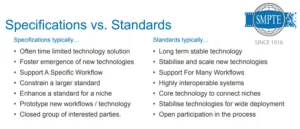Bruce Devlin used his presentation at the HPA Tech Retreat to discuss a new initiative within SMPTE: Specifications. He noted that the organization typically focuses on the development of standards, but there is a need for specifications as well. He differentiated the two as shown in the chart below. In a nutshell, a specification is more targeted for a particular application or workflow while a standard is a more generalized document able to accommodate numerous technologies, applications and workflows.
So why is a specification needed? The answer is that it is more industry and SMPTE member-driven rather than driven by standards body contributors. Documents associated with the specification would also be publically available and free to access on the SMPTE web site – standards documents are neither.
To me, this sounds like the way VESA organized the recent displayHDR specifications with three categories and test procedures developed by manufactures based on available and near term products. In others words, a very practical industry-focused document with business requirements in mind, not an industry-guiding standard. The prototype SMPTE Specifications process will be exercised with the first documents, and the process itself will be documented and reviewed by the SMPTE Board of Governors before being offered to the industry as a specifications service open to all.
Devlin then described the first effort to develop a specification in partnership with the UK-based Digital Production Partnership (DPP). Following the HPA Tech Retreat event, SMPTE issued a press release stating that the effort has now culminated in the first Specification. “Now out for public comment, the draft specification for IMF for broadcast and online applications will address constraints including MXF Track Files, composition playlists (CPLs), output profile lists (OPLs), and IMF packages. The specification will reference other activities as well, such as the EBU.io/qc project for carrying quality-control metadata and EBU-TT, and it includes optional methods for carrying traditional EBU-STL subtitles in Europe and CTA-608/CTA-708 captions in North America,” read the statement..
“Built upon the IMF standard, this first SMPTE Specification will play a critical role in enabling broadcasters to use IMF workflows with their existing content archives, and it also will facilitate the realization of file-based interoperability on a large scale. By providing manufacturers with the guidance they need to move forward in designing and building readers, writers, and analyzers, the specification will bring the benefits of IMF more fully into the broadcast and online realm.” – CC
The group will work on a new specification regarding IMF broadcast and OTT production with the goal of developing the spec by this summer. – CC

